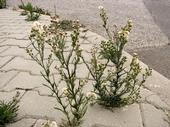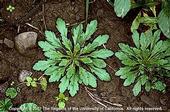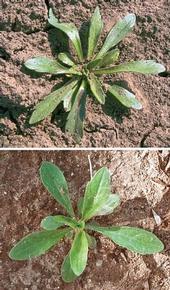- Author: Marie Jasieniuk
- Posted by: Gale Perez

Herbicides are the main means of controlling weeds. Recently, there has been increasing concern over the potential impacts of climate change, specifically, increasing temperatures and elevated carbon dioxide (CO2) concentrations, on the sensitivity of weeds to herbicides. A postdoctoral fellow in my lab, Maor Matzrafi, investigated the response of horseweed and lambsquarters to treatment with glyphosate under the higher temperatures and CO2 levels that are predicted to exist in northern California around 2050. Maor showed that the sensitivity of both weeds to glyphosate was reduced in response to increased temperature, elevated CO2 level, and the combination of both factors. He also found that...
- Author: Ben Faber
- Posted by: Gale Perez

A recent call about the poor control of marestail (horseweed, Conyza canadensis) to glyphosate (Roundup®) wasn't surprising, but that paraquat didnt do the trick was. It turns out that there is multiple resistance to the materials. If horseweed is resistant to glyphosate it is possibly going to be resistant to paraguat which also means that hairy fleabane which has glyphosate resistance could also show resistance to paraquat. A recent study reports on the increased Conyza resistance to paraquat (Distribution of Conyza sp. in Orchards of California and Response to Glyphosate and Paraquat, Moretti et al,
- Author: Ben Faber
- Posted by: Gale Perez

Here's the latest from the UC ANR Topics in Subtropics blog written by Ben Faber, Farm Advisor, UCCE Ventura County.
It really has gotten out of hand--Hairy Fleabane and Horseweed which are both Conyza weed species that have run rampant this year because of the extra rain. It's also because they have become resistant to glyphosate herbicide. The problem has shown up all over the US and other parts of the world. Gradually as resistance has grown and their resistant fairy seeds have floated wherever the winds go, the weed is having a field day everywhere in...
- Author: Ben Faber
- Re-posted by: Gale Perez

From the Topics in Subtropics blog ∴ June 15, 2016
Researchers have now confirmed that six glyphosate-resistant weed species have been identified in California. Four have been known to exist for some time; they are horseweed (marestail, Conyza spp.), hairy fleabane, rigid ryegrass and annual ryegrass. To that list, junglerice and Palmer amaranth in the Central Valley have been recently added to the list. Additional weeds that have become more of a challenge to control and are on the suspect list are goosegrass and, in the central San Joaquin Valley, the summer grasses sprangletop and witchgrass.
There have never been a lot of...
- Author: Sonia Rios

As a farm advisor many growers will ask, “What is that in my grove- horseweed or fleabane?” These two weeds have been running rampant in Southern California, as well as other parts of the state and can be seen in every cropping system imaginable. Their population numbers can be alarming and can start to become troublesome to growers as they can easily become A challenge to control if left untreated. These two members of the of the Conyza family are particularly fond and thrive in permanent tree crop environments due to lack of tillage and lack of a crop rotation schedule due to the trees permanent...


